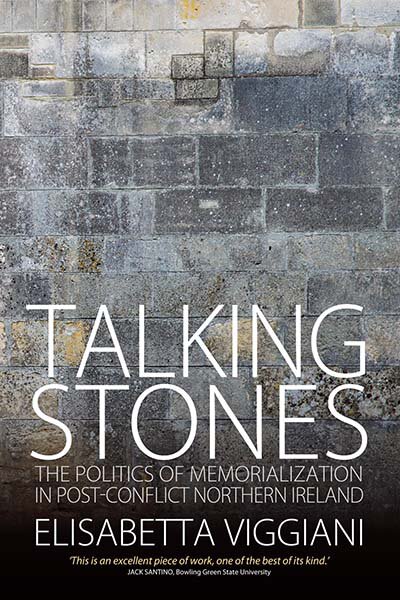Home -> Title

Contents
List of Figures
List of Tables
Foreword by Hastings Donnan
Acknowledgments
List of Abbreviations
Introduction: Memorials as Silent Extras or Scripted Actors?
- Book Outline
Chapter 1. Collective Memory and the Politics of Memorialisation: a Theoretical Overview
- Memory in the Social World: Collectiveness versus Individuality
- The Shaping of Collective Memory: Present versus Past
- Lieux de Mémoireas Conveyors of Social Memory
-
Politicised Remembering: the Nexus between Memory and Power
- The Politics of War Memory and Commemoration
- The Memory Makers and the Projection of Narratives about the Past
-
Methodological Framework
- Database of Memorials
- Survey of Local Population
- Interviews
- Commemorations
Chapter 2. The Armalite and the Paintbrush: a Brief History of Memorialization of the Troubles in Northern Ireland
-
Commemorating during the Troubles
- Funerals and Communal Burials
- Annual Commemorations
-
The Mural Painting Tradition in Northern Ireland
- The Early Years
- Armed Struggle and Party-political Murals
- Post-ceasefire and Peace Process Murals
-
The 1998 Agreement and the ‘Boom’ of Permanent Memorialization
- Post-Agreement Murals
-
Permanent Memorials
- Memorials to Paramilitary Combatants
- Memorials to Civilian Casualties
- Memorials to Security Forces
- Memorials in Government Buildings, Party Offices, Workplaces and Churches
- Commemorative Banners and Memorial Bands
- Memorial Publications, Commemorative Pamphlets and Oral History Projects
- Memorial Prizes, Awards and Trophies
- Post-conflict Commemorations
- Peace or Cross-community Memorials
Chapter 3. The ‘Landscape of Memorialization’ in Belfast: Spatial and Temporal Reflections
- ‘New’ Cultural Geography and the Concept of Landscape as ‘Text’
- Belfast and the Ethnicization of Space
-
The Spatial Dimension of Memorialization
- Memorials as Territorial Markers
- Memorials as Aide-Mémoires
- Memorials as Sacred Places
-
The Temporal Dimension of Memorialization
- Memorials: End of the War or Continuation through Different Means?
- Memorials: still here or never again?
- Memorials as Identity ‘Crutches’
Chapter 4. The ‘Memory Makers’ and the Projection of Narratives of the Troubles
- Individual ‘Stories’ versus the Collective ‘History’ of the Troubles: the Power of the Narrative
-
Republican and Loyalist Memorials: the Projection of Opposing Narratives of The Troubles
- Two Imagined Communities: Creating a Symbolic National Identification
-
Cherry-picking from History: Opposing Versions of a Shared Past
- Ancestries of Resistance: Manufacturing Genealogies
- Forgetting to Remember: Social Amnesia and Euphemization
- Delegitimizing the Enemy: Demonization and Stigmatization
- Talkative Dead Bodies: the Politics of Commemorations
Chapter 5. The Clonard Martyrs Memorial Garden: Constructing a Dominant Republican Narrative
-
The 1998 Agreement and the Prisoners’ ‘Issue’: the Formation of Ex-prisoners’ Groups
- The Greater Clonard Ex-Prisoners’ Association
- Enlisting the ‘Unsung Heroes’ in the Republican Narrative: Local History and Memorial Projects
-
The Clonard Martyrs Memorial GardeN
- Planning Permission and Relationship with Local Authorities
- Funding, Building Materials and Manpower
- Construction of a Successful Dominant Narrative: Iconography, Language and Historical Selection
- Perpetuating Collective Memory: Periodic cCommemorations in Clonard
Chapter 6. The IRSP/INLA Teach Na Fáilte Memorial Committee: Constructing a Sectional Republican Narrative
- The IRSP/INLA Teach Na Fáilte Memorial Committee
- Reclaiming a Place in History for the INLA: the 1981 Hunger Strike
-
Advancing a Sectional Narrative of the Troubles: the Belfast Teach Na Fáilte’s Memorial Programme
- Unveiling ceremonies
- Provisional Republican and Republican Socialist Commemorations
- Opposing the Dominant Republican Narrative: Post-1998 Republican Socialist Rhetoric
Chapter 7. The 1913 UVF and the Myth of the Somme: Constructing a Loyalist ‘Golden Age’
- ‘Lest We Forget’: Loyalist Landscape of Memorialization
-
‘From the Battlefields of the Somme to the Barricades of the Shankill’: Borrowing Legitimacy
- Mainstream Unionism, Republicanism and the Modern UVF Narrative
-
Disraeli Street: an Iconic Cluster of Memory
- Loyalist Commemorations in Memory of Paramilitary Casualties
- Changing with the History Tune: the Evolution of the UVF Narrative
Chapter 8. The UDA Sandy Row Memorial Garden: Attempting a Narrative of Symbolic Accretion
- ‘You Are now Entering Loyalist Sandy Row’
- Tiptoeing through History in Search of Illustrious ‘Forefathers’
-
The Sandy Row Memorial Garden: Attempting to Appropriate the Myth of the Somme
- Lay Out and Iconography
- Role of Families in the Memorial Process
- Remembrance Day
- ‘What the World Needs now Is Love, Sweet love’: 2007 UDA Remembrance Sunday
- ‘Awakening the Sleeping Giant’: Macro and Micropolitics at Commemorations
Chapter 9. Dissecting Consensus: Memory Receivers and the Narrative’s ‘Hidden Transcript’
- Paramilitary Groups and Local Communities: a Complex Relationship
-
Coexisting in Ambivalence: Memorials and Local Residents
- Consultation and ‘Ownership’
- Cohabiting the Same Space
-
Reasons behind Memorialization
- Social Memory
- Territorialization
- Historical Change
- Politico-ideological Exercise
Chapter 10. The Memory of the Dead: Seeking Common Ground?
- At Last, a Common Ground in Northern Ireland?
Appendix A: List of Memorials
Appendix B: Emblems and Flags
Bibliography
Index
Talking Stones
The Politics of Memorialization in Post-Conflict Northern Ireland
Elisabetta Viggiani
Foreword by Hastings Donnan
288 pages, 20 illus., 11 tables, bibliog., index
ISBN 978-1-78238-407-6 Hb Published (August 2014)
ISBN 978-1-78533-341-5 Pb Published (September 2016)
eISBN 978-1-78238-408-3
web ISBN 978-1-78238-408-3

